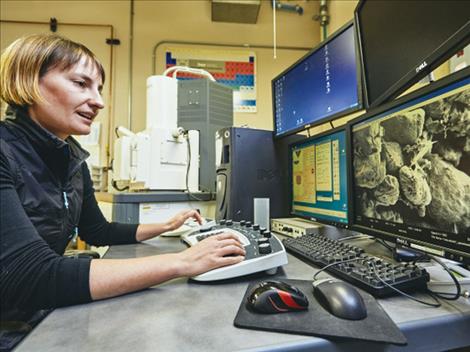Montana State researcher envisions living building materials that function like bone
Hey savvy news reader! Thanks for choosing local.
You are now reading
1 of 3 free articles.
BOZEMAN — Microbes and bacteria and biofilms – oh my! Though most of us go about our daily business without thinking much of the invisible lifeforms that exist all around us, Montana State University assistant professor Chelsea Heveran is looking for ways to use them to meet sustainability challenges in the building industry.
The journal Matter recently published a paper by Heveran, who teaches in the Department of Mechanical and Industrial Engineering in MSU’s Norm Asbjornson College of Engineering. She is the lead author of “Make engineered living materials carry their weight,” which she calls a “perspective piece” exploring the concept of incorporating engineered living materials, or ELMs, into building materials to significantly reduce carbon emissions and environmental costs during manufacture of things like concrete and cement.
“We want to use the functionalities of living cells to help make building materials more sustainable,” Heveran said. The article states that manufacturing the materials used in structures accounts for more than 25% of global carbon emissions, and that one way to reduce the impact is to replace some of their traditional components with materials made by, or including, microbes. Already, one Colorado company is manufacturing light-duty cinder blocks with a mineral formed from photosynthetic algae through a method requiring far less carbon than traditional processes, Heveran said.
So far, though, engineers have not figured out how to keep cells alive for the long term in structures capable of bearing heavy loads. Heveran’s paper suggests that engineers could learn much by studying how living bone functions.
“Bones, which both maintain living cells for decades and support structural loads, often provide mechanical function for an entire lifetime without undergoing mechanical failure. Such a long service life is almost unheard of in engineered devices such as vehicles and machines,” Heveran said. “Bone is able to maintain excellent material properties for much longer than most engineering materials because of the coordinated repair and replacement activities performed by resident bone cells.”
Could engineers design ELMs to function similarly?
“We could get closer to meeting the sustainability potential of engineered living building materials if we can surmount the twin challenges of keeping cells alive longer and generating materials to be stronger,” Heveran said. “Right now, the stiffest engineered living materials that we have can only be used for relatively low-load applications.”
Heveran says that cells used in bone-inspired engineered living materials do not need to be bone cells – common soil microbes that are associated with biomineral production in nature, such as calcite and vaterite, could perform the desirable functions in engineered living materials. Instead, bone can serve as an inspiration for how vascular-like networks can help keep cells alive in rigid materials for a long time so that they can perform desirable functions, like sensing and repairing cracks.
Heveran isn’t the only professor on campus working to further ELM technology – she named several researchers in MSU’s Center for Biofilm Engineering involved in team-based ELM projects. Robin Gerlach, Adrienne Phillips, Erika Espinosa-Ortiz, Recep Avci, Matthew Fields and others are actively working on federally funded engineered living materials projects.
“By many measures, Montana State University is leading the way in the engineered living materials domain,” she said.
As part of the annual Montana Biofilm Meeting in July, MSU hosted the first-ever ELM conference attended by 140 people from universities, private companies and MSU researchers, including students.
“It was very exciting to get everybody together this summer to have conversations that let us resolve scientific, regulatory and legal challenges that are currently barriers to ELMs entering society,” Heveran said.
















